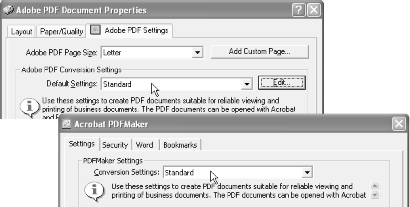Hack 38 Acrobat Distiller and Its Profiles
![]()
![]()
Select the best Distiller profile for your purpose.
When you use Acrobat's "Print to PDF" or use the PDFMaker macro for Word, Adobe's Distiller is the engine that creates your PDF. What kind of PDF do you need? You can configure Distiller to create the best PDF for your purpose. The choice is usually between document fidelity and file size. File size becomes an issue only when distributing a PDF electronically. When in doubt, choose fidelity.
4.8.1 Changing the Distiller Profile
Acrobat Distiller comes with a few preconfigured profiles. They are also called Settings or joboptions files. When printing to PDF, change the profile by clicking the Print dialog's Properties button (Windows), or by selecting PDF Options from the drop-down box that starts out saying Copies & Pages (Mac). Select the Adobe PDF Settings tab and select a Distiller profile from the Default Settings: (Acrobat 6) or Conversion Settings: (Acrobat 5) drop-down box. This choice is not permanent. To change the default profile, consult the Adobe PDF (Acrobat 6) or Acrobat Distiller (Acrobat 5) printer properties.
When using
PDFMaker on Windows, change its profile inside
Word by selecting Adobe PDF 

Figure 4-6. Distiller settings, which you use whenever you create PDFs using Acrobat

When creating a PDF for a print shop or service bureau, ask them for
a joboptions file to use. On Windows, move it to
Distiller's Settings folder,
which is located somewhere such as C:\Program
Files\Adobe\Acrobat 5.0\Distillr\Settings\. On the
Macintosh, open Distiller and use the Settings 
4.8.2 Stock Distiller Profiles, Side by Side
Each profile that comes with Acrobat has subtle differences. We highlight only the big differences in Tables Table 4-1 and Table 4-2 because they have the greatest effect on your PDF.
|
Smallest File Size |
Standard |
High Quality and Press Quality | |
|---|---|---|---|
|
Color Image Resolution (dpi) |
100 |
150 |
300 |
|
Gray Image Resolution (dpi) |
150 |
150 |
300 |
|
Mono Image Resolution (dpi) |
300 |
300 |
1200 |
|
Compressed Image Fidelity |
Low |
Medium |
Maximum |
|
Embedded Fonts |
None |
[1] |
All |
[1] All fonts are embedded except Base 14 fonts and these Windows system fonts: Century Gothic, Georgia, Impact, Lucida Console, Tahoma, Trebuchet, and Verdana.
|
Screen |
eBook |
|
Press | |
|---|---|---|---|---|
|
Color Image Resolution (dpi) |
72 |
150 |
300 |
300 |
|
Gray Image Resolution (dpi) |
72 |
150 |
300 |
300 |
|
Mono Image Resolution (dpi) |
300 |
300 |
1200 |
1200 |
|
Compressed Image Fidelity |
Medium |
Medium |
High |
Maximum |
|
Embedded Fonts |
None |
All Except Base 14 |
All |
All |
A 150 dpi image is usually appropriate for printing on a 600 dpi black-and-white laser or inkjet printer. So, the Standard profile (Acrobat 6) seems to suit most purposes. Color printers can take advantage of higher image resolutions. Visit http://www.scantips.com/basics03.html to discover the principles of printer arithmetic.
In Acrobat 5, the eBook profile serves most purposes; it resembles the Standard profile very closely. Who would have guessed that?
|
If your readers will be downloading files from the Web or receiving them through email, using the Smallest File Size (Acrobat 6) or Screen (Acrobat 5) profile will ensure that low-bandwidth users aren't clobbered with long PDF downloads. On the other hand, if you're sending files to a printer and want the best results possible, you'll want to use the Press Quality profile, which yields the highest-fidelity PDF.







